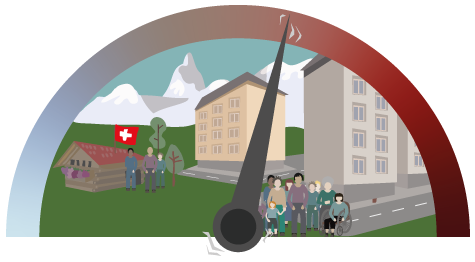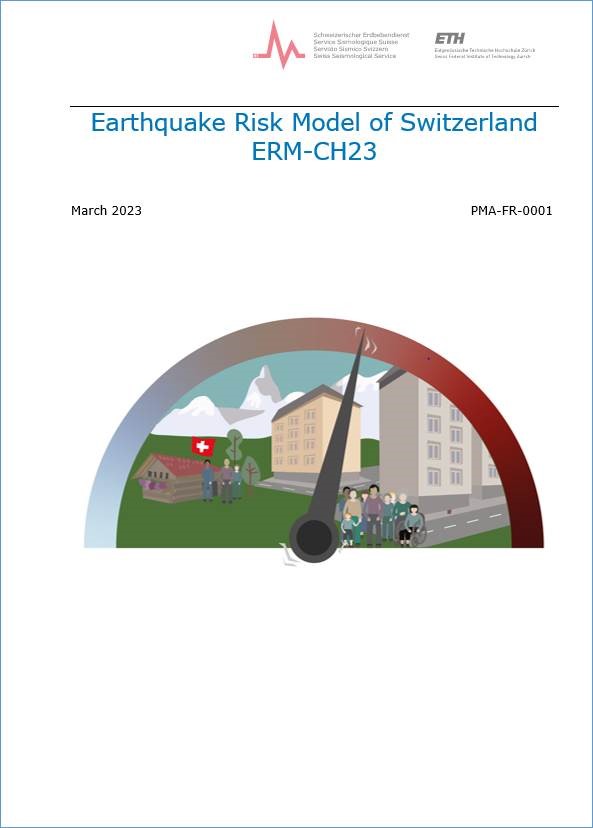As of 2023, Switzerland has the first national and publicly accessible earthquake risk model. The model was developed by the Swiss Seismological Service (SED) at ETH Zurich at the request of the federal government, in collaboration with the Federal Office for the Environment (FOEN), the Federal Office for Civil Protection (FOCP), EPFL and other partners from industry.
The earthquake risk model is part of the federal government's programme of measures for earthquake mitigation, coordinated by the FOEN, the aim of which is to ensure comprehensive seismic risk management at federal level. Furthermore, the federal government's strategy of integrated risk management for natural hazards requires that these risks be transparently quantified and periodically updated and communicated in accordance with the latest knowledge. The earthquake risk model of Switzerland also makes a significant contribution to this objective.
Benefits of the earthquake risk model
The earthquake risk model and the products derived from it are used for earthquake mitigation and preparedness, event response, awareness-raising and as a basis for specific risk analyses.
- Specifically, the following applications are possible:
- Rapid impact assessments that allow an earthquake’s effects to be estimated shortly after it has happened, thereby supporting event response.
- Scenarios showing the impacts of historical earthquakes today or of any future earthquakes, thereby supporting earthquake mitigation and preparedness.
- Estimates of the earthquake risks for building portfolios, helping owners and insurance companies to make informed decisions around earthquake mitigation.
- Information to better assess potential damage and risks at federal, canton and commune level.
- Documentation for carrying out cost-benefit analyses, for example of preventive measures.
- Parameters for examining and optimising coverage and financing models.
- Contribution to further scientific studies.
- Provision of additional products, e.g. for risk assessment in geothermal projects or determination of time-dependent earthquake risk in the event of earthquake swarms.
Model development
The model estimates the vulnerability of Switzerland's more than 2 million residential, commercial and industrial buildings by identifying the vulnerability of various representative building types based on their characteristics and dividing them into vulnerability classes. The building stock was statistically assigned to these classes based on simple characteristics such as the number of storeys or the construction period. This, combined with information on the people and assets affected, makes it possible to determine the consequences for residents and the financial losses. The latter are expressed as a proportion of the building reinstatement costs. The majority of Swiss buildings were not built in accordance with the currently applicable building standards for earthquake-resistant construction.
In addition, improved data on the amplifying effects of the subsoil conditions provide a significantly better picture of local impacts. The data include the amplifications relative to the reference rock for earthquakes recorded at 245 seismic stations in Switzerland in the years 2000-2022. The shear-wave velocity profiles and natural ground frequencies measured at numerous sites helped to model the observed amplifications.
The technical report 'Earthquake Risk Model of Switzerland (ERM-CH23)' provides comprehensive documentation about the risk model.
Model uncertainties
The earthquake risk model of Switzerland is state-of-the-art in terms of technology and research. Moreover, the quantification of uncertainties goes further than in the commercial models.
Model uncertainties Despite the improved data, uncertainties in the modelling mean that there are likely to be differences compared with the actual impacts of an earthquake. The earthquake risk model will be further refined and calibrated in the coming years to reduce these uncertainties and so improve the model results.
Data access for professionals
The data forming the basis for the earthquake risk model of Switzerland (ERM-CH23) are currently being processed. In due course, various components will be made available on the European Facilities for Earthquake Hazard and Risk (EFEHR) data portal.
The technical report 'Earthquake Risk Model of Switzerland (ERM-CH23)' provides comprehensive documentation about the risk model. It sets out why and for what purposes seismic risk analyses are required and what is included in the first publicly accessible earthquake risk model for Switzerland. This is followed by detailed descriptions of the model components, composition and calculation as well as the results. The report closes with an overview of the products designed and tested for different target groups and a look ahead to future developments.
The CC BY licence applies to all data and materials relating to the earthquake risk model of Switzerland.

Financing
The earthquake risk model for Switzerland costs CHF 4.5 million to develop. The costs were shared equally between the FOEN, FOCP and ETH Zurich.
